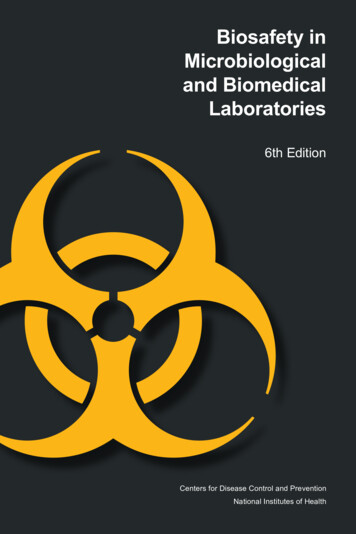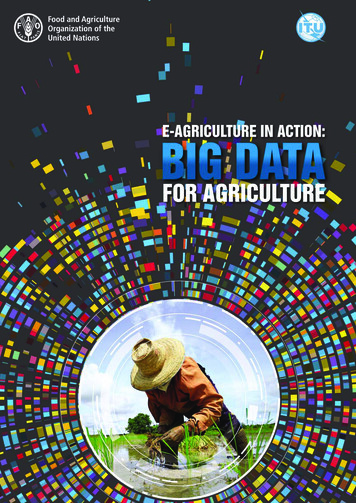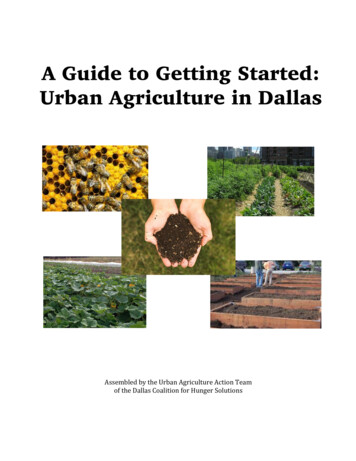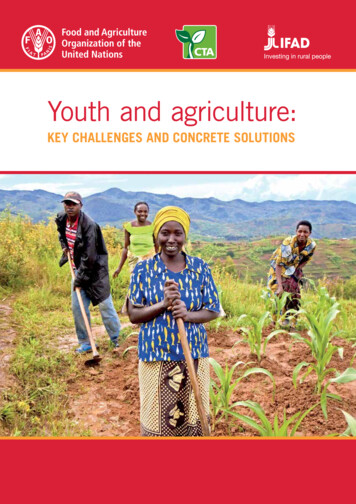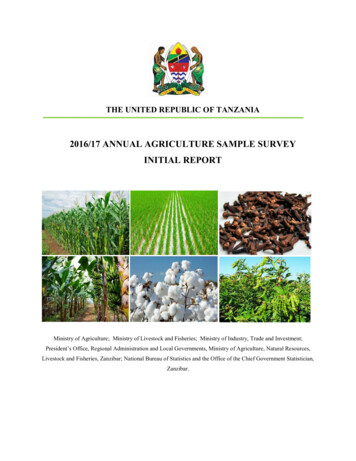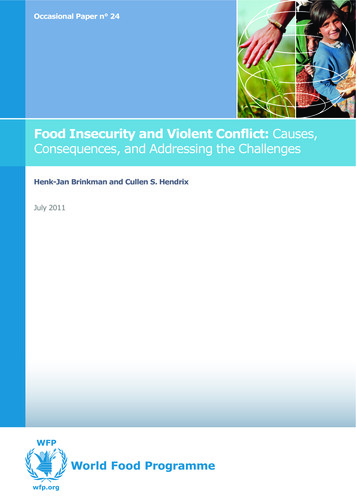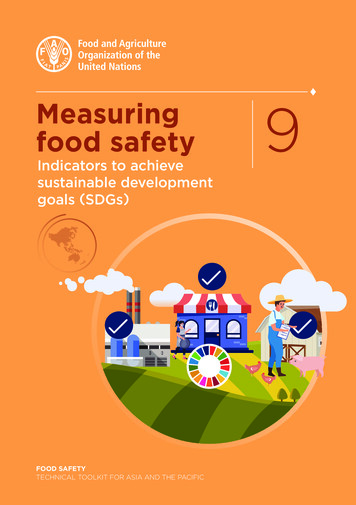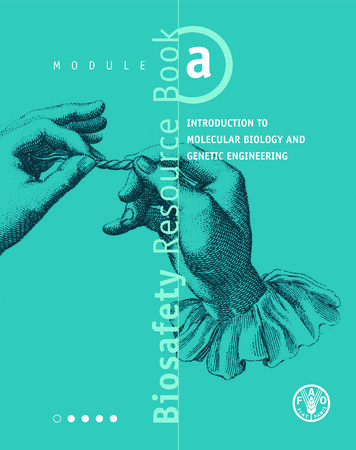
Transcription
aBiosafety Resource Bookm o d u l eIntroduction toMolecular Biology andGenetic Engineering
aBiosafety Resource Bookm o d u l eIntroduction toMolecular Biology andGenetic EngineeringOliver BrandenbergZephaniah DhlaminiAlessandra SensiKakoli GhoshAndrea SonninoFood and AgricultureOrganization ofthe United NationsRome, 2011
abcdemodulesfore wordDuring the period 2002–10, FAO undertook an intense activity of biosafetycapacity development, largely centred on enhancing the capacities ofregulators and other technical staff involved in the implementation ofbiosafety frameworks, along with other components. The training programmewas tailored to meet the needs of a very specific audience: biosafetyregulators, policy-makers and members of national biosafety committees,with diverse educational backgrounds, not necessarily well versed in allthe biosafety-related fields. The training courses therefore aimed to:i) offer background knowledge critical in the process of reviewing biosafetydossiers and biosafety-related decision-making; ii) provide acquaintancewith concepts and methodologies relevant to risk analysis of GMO releaseand biosafety management.iii
The training programme consisted of the following modules:aModule aMolecular biology and genetic engineering, which reviews the verybasic scientific concepts and principles employed in producing GMOs, andprovides a brief description of current and emerging uses of biotechnology incrops, livestock and fisheries.bcModule bEcological aspects, which provides the necessary background informationon ecology and evolution needed to analyse and understand the consequencesof introducing GMOs into the environment.Module cRisk analysis, which provides basic information on biological risks, concepts,principles, and methodologies of risk assessment, risk management and riskcommunication. It focuses on crop biotechnology and environmental risk assessmentof GM crops since these are of immediate interest to most countries.dModule dTest and post-release monitoring of GMOs, which addresses the useand monitoring of GMOs under containment, confinement and limited fieldtrials, as well as the monitoring of commercially released GMOs. It also coverssurveillance and emergency planning.eModule eLegal aspects, which provides an overview of the existing legal tools andframeworks on biotechnology and biosafety, and offers a thorough description ofthe international instruments that regulate biosafety and their interactions.iv
This Biosafety Resource Book stems from experience gained in biosafetycapacity development projects and is based on the materials developed bythe lecturers who have taught in the training courses organized to date.The Resource Book has been prepared in response to an expressed need,with the purpose of being used as a training tool in future activities. TheResource Book also aims at providing biosafety regulators, policy-makersand members of national biosafety committees with reference materialsthat can be readily consulted beyond the training events, when the needarises. Special attention has been paid to avoid technical jargon and to keepthe modules scientifically accurate as well as accessible to non-specialists.FAO’s biosafety capacity building activities are the result of a collaborativeeffort, involving numerous institutions, including national biosafetycommittees of many countries, ministries, universities and research institutes,NGOs and the private sector. The precious contribution of national projectcoordinators, national and international consultants, as well as FAO officersfrom headquarters and decentralized offices, is gratefully acknowledged.The enthusiasm and dedication of the participants in the training activitieswere crucial for their success.Andrea SonninoChief,Research and Extension BranchOffice of Knowledge Exchange,Research and Extensionv
vi
List of contributorsThis module has been prepared based on the lectures and contributions of:Oliver BrandenbergResearch and Extension BranchFood and Agriculture Organization ofthe United Nations (FAO)Rome, Italy(present address:Institute of Medical Virology,University of Zürich,Zürich, Switzerland)Hosea Ken MatengoDepartment of Molecular Biology andBiotechnologyUniversity of Dar-es-SalaamDar es Salaam, United Republic of TanzaniaEmmarold E. MneneyMikocheni Agricultural Research Institute (MARI)Dar es Salaam, United Republic of TanzaniaZephaniah DhlaminiSam Kwame OffeiRichard EdemaLeonard O’GarroDepartment of Applied Biology & BiochemistryNational University of Science and TechnologyAscot, Bulawayo, ZimbabweDepartment of BiotechnologyMakerere UniversityKampala, UgandaHrvoje FulgosiDepartment of Crop ScienceUniversity of GhanaLegon, GhanaDepartment of Biological and Chemical SciencesFaculty of Pure and Applied SciencesUniversity of West IndiesCave Hill, BarbadosDepartment of Molecular BiologyRudjer Boskovic InstituteZagreb, CroatiaAjaj ParidaKakoli GhoshAlessandra SensiPlant Protection and Production DivisionFood and Agriculture Organization ofthe United Nations (FAO)Rome, ItalyAntonietta Gutiérrez-RosatiUniversidad Nacional AgrariaLa Molina, Lima, PerúAndrew KiggunduNational Agricultural Biotechnology LaboratoryKawanda, UgandaJesse MachukaDepartment of Biochemistry and BiotechnologyKenyatta UniversityNairobi, KenyaM. S. Swaminathan Research Foundation (MSSRF)Chennai, IndiaResearch and Extension BranchFood and Agriculture Organization ofthe United Nations (FAO)Rome, Italy(present address:EuropeAid Co-operation Office, Unit A.3Centralised Operations for Europe, theMediterranean and the Middle EastBrussels, Belgium)Andrea SonninoResearch and Extension BranchFood and Agriculture Organization ofthe United Nations (FAO)Rome, Italyvii
forewordLIST OF CONTRIBUTORSLIST OF ABBREViATIONSchapter 1INTRODUCTION TO BIOTECHNOLOGY: BASIC CONCEPTS AND DEFINITIONS1.1 Definition of biotechnology1.2 Overview of applications of biotechnologyviiimodulec o nt e ntsaiiiviix115chapter 2STRUCTURE AND FUNCTION OF GENES2.1 Genes and heredity2.2 The structure of DNA2.3 The flow of genetic information: the central dogma2.4 The genetic code2.5 The gene2.6 The arrangement and layout of genes2.7 Gene expression2.8 regulation of gene transcription2.9 Regulatory mRNA sequences991012121517182125chapter 3VECTORS AND PROMOTERS3.1 Recombinant DNA technology – an overview3.2 Vectors3.3 Types of cloning vectors3.4 Promoters3.5 Expression vectors292930313537chapter 4PLANT TRANSFORMATION AND SELECTION TECHNIQUES4.1 Plant transformation4.2 Plant tissue culture4.3 Plant transformation techniques4.4 Selection of successfully transformed tissues4.5 Selectable marker genes (SMG)4.6 Molecular analysis of transgenic plants4.7 Application of transgenic plants4141424351525455
chapter 5BIOTECHNOLOGY IN ANIMAL PRODUCTION5.1 Biotechnology in animal breeding and reproduction5.2 Genetic markers and marker-assisted selection (MAS)5.3 Transgenic animals5.4 Applications for transgenic animals5.5 Biotechnology in animal health5.6 DNA technologies in animal nutrition and growthchapter 6GENETIC ENGINEERING OF MICRO-ORGANISMS OF INTEREST TO AGRICULTURE6.1 Introduction6.2 Genetically modified micro-organisms asbiopesticides and biofertilizers6.3 Micro-organisms for enhancing the use of animal feeds6.4 Genetically modified micro-organisms in food processing6.5 Genetically modified micro-organisms in bioremediationchapter 7GMO DETECTION, IDENTIFICATION AND QUANTIFICATION METHODS7.1 Introduction7.2 Sampling procedures7.3 Sample preparation procedures7.4 GMO detection by phenotypic characterization7.5 Molecular detection and quantification of GMOs –DNA-based methods7.6 Molecular detection and quantification of GMOs –protein-based methods7.7 Molecular detection and quantification of GMOs –other methods7.8 Summary of GMO analysis: limits and outlookannex 1GENES OF INTEREST TO AGRICULTUREA1.1 IntroductionA1.2 Herbicide tolerance genesA1.3 Resistance to biotic stressesA1.4 Tolerance to abiotic stressesA1.5 Quality traitsA1.6 Transgenic plants as bioreactors for biopharmaceuticalsand 959899109113115118118119120121122123124ix
LIST OF ABBREViATIONSAAIALSAmpARSATPA. tumefaciensBACbpBSEBtCCaMVCATCBDCTABDNAdsDNAE. coliELISAEPSPSES cellETFAOFDAGGFPGMOGUSHPLCISOAdenineArtificial inseminationAcetolactate synthaseAmpicillinAutonomously replicating sequenceAdenosine triphosphateAgrobacterium tumefaciensBacterial artificial chromosomebase pairBovine Spongiform EncephalopathyBacillus thuringiensisCytosineCauliflower mosaic virusChloramphenicol acetyltransferaseConvention on Biological DiversityCetyl trimethylammonium bromideDeoxyribonucleic acidDouble-stranded DNAEscherichia coliEnzyme-linked immunosorbent assay5-enolpyruvylshikimate-3-phosphate synthaseEmbryonic stem cellEmbryo transferFood and Agriculture Organization of theUnited NationsU.S. Food and Drug AdministrationGuanineGreen fluorescent proteinGenetically modified organismBeta-glucuronidaseHigh performance liquid chromatographyInternational Organization for RPEGPPTQTLRNArRNART-PCRS. aureusSCNTSMGsnRNPSTTT-DNATiTMVtRNAUUTRvir genesYACInternational Seed Testing AgencyIn vitro fertilizationkilobaseMarker-assisted selectionMegabaseMultiple cloning siteMessenger RNAOocyte pick-upOpen reading frameOrigin of replicationPhosphinothricin acetyltransferasePolymerase chain reactionPolyethylene glycolPhosphinothricinQuantitative trait lociRibonucleic acidRibosomal RNAReverse transcriptase PCRStaphylococcus aureusSomatic cell nuclear transferSelectable marker genesmall nuclear ribonucleoproteinsSomatotropinThymineTransfer DNATumour-inducingTobacco mosaic virusTransfer RNAUracilUntranslated regionvirulence genesYeast artificial chromosomeFor further explanation of terminology and other abbreviations, please refer to the FAO“Glossary of biotechnology for food and agriculture” (FAO, 2007), which is also available online at:http://www.fao.org/biotech/index glossary.asp?lang enx
chapter1INTRODUCTIONTO BIOTECHNOLOGY:BASIC CONCEPTS ANDDEFINITIONS1.1 Definition of biotechnologyThe term biotechnology was coined in 1919 by Karl Ereky, a Hungarian engineer.At that time, the term included all the processes by which products are obtainedfrom raw materials with the aid of living organisms. Ereky envisioned a biochemicalage similar to the stone and iron ages.Nowadays, according to the Convention on Biological Diversity (CBD), Biotechnologyis defined as “any technological application that uses biological systems, livingorganisms, or derivatives thereof, to make or modify products or processes forspecific use” (CBD, 1992). The living organisms or derivatives thereof most frequentlyused include micro-organisms, animals and plants (or their isolated cells) as wellas enzymes. They can be utilized to process substances, usually other natural,renewable materials, or serve themselves as sources for valuable substances or goods.Several branches of industry rely on biotechnological tools for the production ofBiotechnologyAny technologicalapplication thatuses biologicalsystems, livingorganisms, orderivativesthereof, to makeor modify productsor processes forspecific use.food, beverages, pharmaceuticals and biomedicals. The CBD definition is applicableto both “traditional” or “old” and “new” or “modern” biotechnology.1
biosafety Resource BookmoduleaIntroduction to Molecular Biology and Genetic EngineeringLong before the term biotechnology was coined for the process of using livingorganisms to produce improved commodities, people were utilizing livingmicro-organisms to obtain valuable products, for example through the processof fermentation.A list of early biotechnological applications is given below in Table 1.1:Table 1.1 Traditional applications of biotechnologyProviding bread with leavenPrehistoric periodFermentation of juices to alcoholic beveragesPrehistoric periodKnowledge of vinegar formation from fermented juicesPrehistoric periodManufacture of beer in Babylonia and Egypt3rd century BCWine manufacturing in the Roman Empire3rd century ADProduction of spirits of wine (ethanol)Vinegar manufacturing industry115014th century ADDiscovery of the fermentation properties of yeast1818Description of the lactic acid fermentation by Pasteur1857Detection of fermentation enzymes in yeast by Buchner1897Discovery of penicillin by Fleming1928Discovery of many other antibiotics 1945Since the middle of the twentieth century biotechnology has rapidly progressedand expanded. In the mid-1940s, scale-up and commercial production of antibioticssuch as penicillin occurred.The techniques used for this development were:»isolation of an organism producing the chemical of interest using screening/selection procedures, and»improvement of production yields via mutagenesis of the organism or optimizationof media and fermentation conditions. This type of biotechnology is limited to2
chapt e rI NTRODUCT I ON TO B I OTEC H NOLOGY : B AS I C CONCEPTS AND DEF I N I T I ONS1chemicals occurring in nature. It is also limited by its trial-and-error approach,and requires a lengthy procedure over years or even decades to improve yields(Rolinson, 1998).About three decades ago, with the advance of molecular biology, biotechnologybecame more of a science than an art. Regions of deoxyribonucleic acid (DNA)(called genes) were found to contain information that directs the synthesis ofspecific proteins. Proteins can therefore be considered as the final product of agene; they are the molecules that carry out almost all essential processes withina cell. Each protein has its own identity and function: many are so-called enzymesthat catalyse (facilitate) chemical reactions, others are structural components ofDNAAcronym forDeoxyribonucleicAcid: The materialin which ourhereditaryinformationis stored.cells and organs (Morange and Cobb, 2000). Today it is possible to express a gene,regardless of its origin, in a simple bacterium such as Escherichia coli (E. coli),so that the bacterium produces large quantities of the protein coded for by thegene. The same principle can be applied to many other micro-organisms, as wellas to higher organisms such as plants and animals.The techniques used for this purpose include:»isolation of the gene coding for a protein of interest;»cloning (i.e. transfer) of this gene into an appropriate production host;»improving gene and protein expression by using stronger promoters, improvingfermentation conditions etc. (Gellisen, 2005). Together, these techniques areknown as recombinant DNA technology and will be discussed at some lengththroughout this resource book.RecombinantDNA technologyThe process ofconstructing andmanipulating DNAsequences that donot occur naturally,by combining DNAfragments fromdifferent sources.About two decades ago, protein engineering became possible as an offshoot ofthe recombinant DNA technology. Protein engineering differs from “classical”biotechnology in that it is concerned with producing new (engineered) proteinswhich have been modified or improved in some of their characteristics (Park andCochran, 2009).3
biosafety Resource BookmoduleaIntroduction to Molecular Biology and Genetic EngineeringThe techniques involved in protein engineering are essentially based on recombinantDNA technology and involve:»various types of mutagenesis (to cause changes in specific locations or regionsof a gene to produce a new gene product);»expression of the altered gene to form a stable protein;»characterization of the structure and function of the protein produced;»selection of new gene locations or regions to modify for further improvementas a result of this characterization.The commercial implications of the technical developments listed above are that a largenumber of proteins, existing only in tiny quantities in nature, can now be produced onan industrial scale. Furthermore, the yields of biochemical production can be increasedmuch faster than what was originally possible with classical fermentation.GeneticallymodifiedOrganismAn organism whosegenetic materialhas been modified,for example byintroducing foreignDNA sequencesobtained byrecombinant DNAtechnology.Importantly, the production of transgenic animals and plants that contain geneticelements from foreign sources and possess novel traits and characteristics is alsobased on the techniques outlined above. As all these approaches result in thecreation of genetically modified organisms (GMOs) that can be potentially harmfulto the environment and human health, the part of biotechnology that deals withGMOs is strictly regulated by biosafety laws and guidelines. The main thrust ofthis resource book is on the development and enforcement of such regulatoryframeworks at domestic and international levels.Biotechnology applications are developed by a collection of multidisciplinary researchactivities, commonly referred to as enabling technologies. Apart from fermentationand genetic engineering/recombinant DNA technology, other important enablingtechnologies are plant and animal cell culture technology and enzyme technology.The basis of these enabling technologies are the scientific disciplines of molecularbiology, genetics, microbiology, biochemistry, protein chemistry, chemical and4
chapt e rI NTRODUCT I ON TO B I OTEC H NOLOGY : B AS I C CONCEPTS AND DEF I N I T I ONS1process engineering and computer science. An overview of important events inthe development of modern molecular biology and recombinant DNA technologyis provided in Table 1.2:Table 1.2 An overview of recombinant DNA-based biotechnologyDouble helix structure of DNA is first described by Watson and Crick1953Cohen and Boyer, amongst others, develop genetic engineering1973The first human protein (somatostatin) is produced in a bacterium (E. coli)1977The first recombinant protein (human insulin) approved for the market1982Polymerase chain reaction (PCR) technique developed1983Launch of the Human Genome Project1990The first genome sequence of an organism (Haemophilus influenzae) is determined1995A first draft of the human genome sequence is completed2000Over 40 million gene sequences are deposited in GenBank, and genome sequences ofhundreds of prokaryotes and dozens of eukaryotes are finished or in draft stage20051.2Overview of applications of biotechnologySince the advance of recombinant DNA technology, several techniques and applicationshave been developed that are benefiting humankind in the areas of agriculture,medicine, environment, industry and forensics. The following sections briefly describesome of these applications and their potential benefits to society.1.2.1 IndustryBiotechnology can be used to develop alternative fuels; an example is the conversionof maize starch into ethanol by yeast, which is subsequently used to producegasohol (a gasoline-ethanol mix). Bacteria are used to decompose sludge andlandfill wastes (Soccol et al., 2003). Through biotechnology, micro-organisms or5
biosafety Resource BookmoduleaIntroduction to Molecular Biology and Genetic Engineeringtheir enzymes can be adapted to convert biomass into feed stocks, or they canbe used for manufacturing biodegradable plastics (bioplastics). Other organisms(micro-organisms, plants and mammals) are used as bioreactors for producingchemical compounds that are extracted from them and processed as drugs andother products. Plant and animal fibres are used for producing a variety of fabrics,threads and cordage. Biotechnology is applied to improve the quality and quantityof these products. Biopulping is a technique whereby a fungus is used to convertwood chips into pulp for papermaking (Gavrilescu and Chisti, 2005).1.2.2 Health and medicineIn the area of health and medicine, biotechnology has numerous and importantfunctions. Biotechnologies are used to develop diagnostic tools for identifyingdiseases.Biotechnology is also used to produce more effective and efficient vaccines,therapeutic antibodies, antibiotics, and other pharmaceuticals. Biotechnology isa USD 70 billion a year industry that has produced several blockbuster drugs andvaccines, i.e. drugs with sales volumes exceeding USD 1 billion per year (Lawrence,2007). Furthermore, there are more than 370 drug products and vaccines obtainedthrough biotechnology currently in clinical trials, targeting more than 200 diseasesincluding various cancers, Alzheimer’s disease, heart disease, diabetes, multiplesclerosis, AIDS and arthritis (Sullivan et al., 2008).Through the biotechnology of gene therapy, scientists are making efforts atcuring genetic diseases by attempting to replace defective genes with thecorrect version. A revolutionary strategy is being developed whereby staplefoods such as potatoes, bananas, and others are used as delivery vehicles tofacilitate the immunization of people in economically depressed regions ofthe world (Tacket, 2009).6
chapt e rI NTRODUCT I ON TO B I OTEC H NOLOGY : B AS I C CONCEPTS AND DEF I N I T I ONS11.2.3 EnvironmentDevelopment and usage of alternative fuels that burn cleaner and improve airquality through reduced pollution of the environment is possible by biotechnologicalmeans. Micro-organisms are used to decompose wastes and clean up contaminatedsites by the technology of bioremediation. The use of disease-resistant cultivarscan make crop production less environmentally intrusive by reducing the use ofagrochemicals (Chatterjee et al., 2008).1.2.4 ForensicsSince the DNA profile, i.e. the nucleotide sequence of the genome, is unique inevery individual, it can be used as a powerful basis of identifying individuals in apopulation. DNA-based evidence is used in cases involving paternity disputes andfamily relationships. Furthermore, it is used in health care and judicial systems.In the judicial system, forensic experts use DNA profiling to identify suspects incriminal cases, especially when body fluids and other particles like hair and skinsamples can be retrieved (Jobling and Gill, 2004).1.2.5 AgricultureBiotechnology can complement conventional breeding for crop and animalimprovement. Instead of extensive re-arrangement of genes, as occurs in conventionalbreeding, biotechnology enables targeted gene transfer to occur. The genome of therecipient individual remains intact, except for the introduced gene (or genes), thusaccelerating breeding programmes and the development of organisms with desirablecharacteristics. Furthermore, biotechnology enables gene transfer across naturalbreeding boundaries, overcoming mating barriers and creating a “universal genepool” or “universal breeding population” accessible to all organisms. Likewise, itis possible to specifically introduce novel, desirable traits and characteristics into7
modulebiosafety Resource Book1aIntroduction to Molecular Biology and Genetic Engineeringexisting species. This biotechnological application is used to improve the yield ofcrop and animal species and their product quality such as nutritional value andshelf life (Shewry et al, 2008). In addition to these benefits, this methodologyreduces the need for agrochemicals by creating disease and pest-resistant species,thereby reducing environmental pollution from chemical runoff. Increased yieldsand higher food quality can contribute to reducing world hunger and malnutrition(FAO, 2004).AgriculturalBiotechnologyAll biotechnologicalapplicationsdeveloped for apotential use inagriculture.Several technologies in the field of agricultural biotechnology exist that do not relyon the creation of GMOs. Molecular techniques are being used to monitor breedingpopulations and to diagnose animals and plants infected with diseases. Micropropagationtechniques are being widely used to generate clonal plant materials, allowing rapidlarge-scale clonal propagation of many plant species including trees. Biofertilizers andbiopesticides can be applied in place of conventional fertilizer and pesticides to promoteplant growth and health in an environmentally sustainable way (FAO, 2001).To summarize, the field of biotechnology is very diverse, both in terms of methodologiesand techniques applied and the potential applications and outcomes. Biotechnologyhas the potential to contribute to a worldwide sustainable development and thereduction of world hunger, including the branches of biotechnology concerned withagricultural research and development (FAO, 2004). Importantly, biotechnology is notonly based on GMOs, but offers several important and well established techniquesthat are not dependent on or derived from genetic modifications. However, thefocus of this publication is on GMOs and related products. Following an introductionto the molecular background and the scientific basis of GMO development and tothe aims and prospects of this research, the main part of this book will introducebiosafety concepts related to the use of GMOs.8
chapter2STRUCTURE ANDFUNCTION OF GENES2.1 Genes and heredityThe study of genes and heredity is called genetics. Heredity phenomena have beenof interest to humans since long before the underlying principles were scientificallyinvestigated and understood. Ancient peoples were improving plant crops andGeneticsThe scienceof genes andheredity.domesticating animals by selecting desirable individuals for breeding. Geneticsas a set of scientific principles and analytical procedures emerged in the 1860swhen the Augustinian monk Gregor Mendel performed a set of experiments thatrevealed the existence of biological “factors” responsible for transmitting traitsfrom generation to generation. These factors were later called genes, followingthe discovery of chromosomes and genetic linkage in the early twentieth century.Up to this point genetics looked at genes as abstract entities that somehowcontrol hereditary traits. Through genetic analyses the inheritance of differentgenes was studied, but the physical and biochemical nature of the gene remainedunknown. Further work revealed that chromosomes consist of DNA and protein,and subsequent studies allowed the conclusion that DNA is, in fact, the hereditarymaterial (Morange and Cobb, 2000).9
modulebiosafety Resource Book1aIntroduction to Molecular Biology and Genetic EngineeringDNA was thought to be a simple molecule, thus many scientists did not believe thatit indeed carried and stored the information for an entire organism. How can suchhuge amounts of information be contained and passed on from one generation tothe next? Clearly, the genetic material must have both the ability to encode specificinformation and the capacity to duplicate that information precisely during every celldivision. What kind of molecular structure could allow such complex functions?2.2 The structure of DNAAlthough the exact DNA structure was not known until 1953, its basic buildingblocks had been known for many years. It had been shown that DNA is composedof four basic molecules called nucleotides, which are identical except that eachcontains a different nitrogen-containing base. Each nucleotide is made up of aphosphate group, a sugar (of the deoxyribose type), and one of the four bases.The four bases are adenine (A), guanine (G) ( the purines) and cytosine (C) andthymine (T) (the pyrimidines; see also Figure 2.1).DNA structureIn 1953, thestructure of DNAwas decipheredand found to bea double helix.This modeloffered possibleexplanations forthe processes ofDNA replication andgene expression.In 1953 James Watson and Francis Crick were the first to succeed in putting thebuilding blocks together and came up with a reasonable DNA structure. They usedDNA X-ray diffraction patterns produced by Rosalind Franklin and Maurice Wilkinsand data from Erwin Chargaff. The X-ray data showed the DNA molecule to be long,thin and helical (spiral-like) in shape.Chargaff had established certain empirical rules about the amounts of eachcomponent of DNA:»The total amount of pyrimidine nucleotides (T C) always equals the totalnumber of purine nucleotides (A G).»The amount of T always equals the amount of A, and the amount of C alwaysequals the amount of G. But the amount of A T is not necessarily equal tothe amount of G C.10
chapt e rSTRUCTURE AND FUNCT I ON OF GENES2The structure that Watson and Crick derived from these clues is a double helix(Figure 2.1). Each helix is a chain of nucleotides held together by phosphodiesterbonds, in which a phosphate group forms a bridge between -OH groups on twoadjacent sugar residues. The two DNA chains (helices) are running in an antiparalleldirection and are held together by hydrogen bonds between opposing bases,thus forming a double helix. Each base pair (bp) consists of one purine and onepyrimidine base, paired according to the following rule: G pairs with C, and A pairswith T (Watson et al., 2008).Figure 2.1 The structure of DNAIn part (A), the four bases, the pairing of the bases and the connection of the basesthrough the sugarphosphate-backbone are depicted. Note that the two DNA strands areheld together through base pairing and are running in opposite direction, labelled 3’ and5’ end respectively (read: three prime and five prime). In part (B), a schematic drawingof the actual DNA double helix structure is depicted, containing the same elements insimplified form and labelling as in (A).AdenineThymine5’ end5’3’SugarPhosphateBackbone3’ endAdenineBase pairThymineNitrogeousbaseGuanine3’ end(A)GuanineCytosine5’ endCytosine(B)11
biosafety Resource BookmoduleaIntroduction to Molecular Biology and Genetic EngineeringElucidation of the structure of DNA caused a lot of excitement in the scientificcommunity for two major reasons. First, the structure suggests an obvious way inwhich the molecule can be duplicated, or replicated, since each base can specifyits complementary base by hydrogen bonding. Thus each strand can serve as atemplate for the synthesis of a complementary strand. Second, the structuresuggests that the sequenc
Molecular BIology and genetIc engIneerIng, which reviews the very basic scientific concepts and principles employed in producing Gmos, and provides a brief description of current and emerging uses of biotechnology in crops, livestock and fisheries. Module B ecologIcal asp
